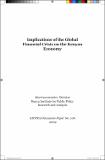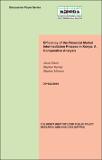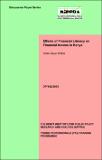| dc.date.accessioned | 2021-02-19T13:38:07Z | |
| dc.date.available | 2021-02-19T13:38:07Z | |
| dc.date.issued | 2009 | |
| dc.identifier.uri | http://repository.kippra.or.ke/handle/123456789/2686 | |
| dc.description.abstract | The Global Financial Crisis (GFC) has been traced back to the late
1990s when the United State (US)’s interest rates on the federal
funds were considerably low, leading to liberal lending practices by
commercial banks to clients. During the crisis, economic
growth in Kenya dipped from 7 per cent in 2007 to 1.7 per cent in
2008, though this drop was largely attributed to internal shocks such
as the post-election violence of 2008, and drought. Exchange rates
also depreciated following a dip in net capital and financial inflows
in the period, foreign reserves reduced as donor flows dropped and
as Central Bank used the available reserves to defend the weakening
shilling. At the sectoral level, the crisis contributed to a decline in
tourist arrivals, manufacturing and in stock market activity... | en |
| dc.language.iso | en | en |
| dc.publisher | The Kenya Institute for Public Policy Research and Analysis (KIPPRA) | en |
| dc.relation.ispartofseries | DP/106/2009; | |
| dc.subject | Financial Inflows | en |
| dc.subject | Commercial Banks | en |
| dc.subject | Internal Shocks | en |
| dc.subject | Financial Crisis | en |
| dc.subject | Stock Markets | en |
| dc.title | Discussion Paper No. 106 of 2009 on Implications of the Global Financial Crisis on the Kenyan Economy | en |
| dc.type | Discussion Paper | en |
| ppr.contributor.author | Kenya Institute for Public Policy Research and Analysis (KIPPRA) | en |




